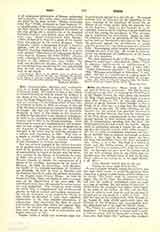

Biot, JEAN-BAPTISTE, physicist and mathematician, b. at Paris, France, April 21, 1774; d. there, February 3, 1862. He studied at first at the College of Louis-le-Grand; in 1793 he joined the artillery of the Army of the North, but soon left the service to enter the Ecole Polytechnique. After going to Beauvais as a professor in the central school of that city, he returned to Paris, in 1800, to occupy, at the age of 26, the chair of mathematical physics in the College de France. He had the distinction of ultimately belonging to three of the classes of the Institute; in 1803 he was admitted to the Academy of Sciences; in 1841, to the Academy of Inscriptions and Belles-Lettres; and in 1856, to the French Academy. After beginning his career as a mathematician and astronomer, he was assigned to the section of geometry in the Academy of Sciences. Among the interesting incidents in his career may be cited his ascension in a balloon with Gay-Lussac in 1804. They rose to a height of 13,000 feet for the purpose of studying the magnetic, electrical, and chemical condition of the atmosphere at various elevations.
Biot was actively engaged in the various branches of the geodetic work involved in the famous measurement of the quadrant of a meridian, for the purpose of standardizing the length of the new unit, the meter. As a member of the Bureau of Longitudes he went, in 1806, with young Arago, to Formentera, in the Balearic Islands, to resume the measurement of a degree of the meridian, interrupted by the death of Mechian. In 1808 he determined, with Mathieu, the length of the seconds pendulum at Bordeaux and Dunkirk. In 1817 he went to Scotland and the Shetland Islands to verify the geodetic operations of the English under Colonel Mudge. In 1824 he returned to Italy, Sicily, and Spain, in order to correct some of the observations of the year 1808. He contributed more than 250 memoirs to various societies and periodicals. This enormous work covers the entire field of experimental and mathematical physics, as well as ancient and modern astronomy. He was the champion of the corpuscular theory of light which he extended to some most ingenious explanations of the very complex phenomena of polarization. Biot discovered the laws of rotary polarization by crystalline bodies and applied these laws to the analysis of saccharine solutions. His fame rests chiefly on his work in polarization and double refraction of light.
Regular habits of study and recreation kept him in good health and led to a ripe old age. His mental attitude may be indicated by his opposition to the open meetings of the Academy; he feared the influence of the vulgar public upon the scientific tone of the Institute. Since he was brought up in the turbulent times of the Revolution, it is not surprising to find him among the insurgents, in 1795, attempting to overthrow the Convention. Again, in 1804, he succeeded at first in prevailing on the Institute not to vote for Bonaparte’s elevation to the throne. He protested against the introduction of purely political matters into the deliberations of a scientific body. His religious views became more pronounced towards the end of his life. He is said to have received the Sacrament of Confirmation at the hands of his own grandson.
The more elaborate works of Biot are: “Traite de geometric analytique”, 1802 (8th ed., 1834); “Traite de physique experimentale et mathematique”, 4 vols., 1816; “Precis de physique”, 2 vols., 1817; “Traite d’astronomie physique”, 6 vols. with atlas, 1850; “Melanges scientifiques et litteraires”, 3 vols., 1858. The last is a compilation of a great many of his critiques, biographies, and accounts of voyages.
WILLIAM FOX

